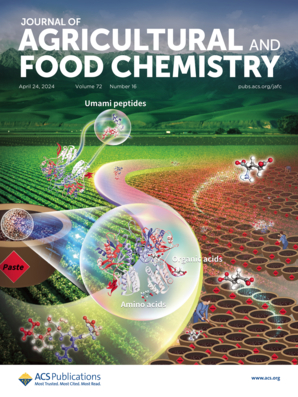Characterization of Phyllobilins in Hops: Antioxidant and Potentially Bitter Senescence-Related Metabolites.
IF 5.7
1区 农林科学
Q1 AGRICULTURE, MULTIDISCIPLINARY
引用次数: 0
Abstract
Hops is of high relevance to the food sector, and increasingly valued as medicinal plant. Its complex phytochemistry includes phenolic compounds and bitter prenylated polyketides, but phyllobilins─bioactive linear tetrapyrroles from chlorophyll catabolism─remain underexplored. In this work, several dioxobilin-type phylloleucobilins (DPleBs) and phylloxanthobilins (DPxBs) were identified in yellowish leaves of common hops (Humulus lupulus). Isolation from 107 g of leaves yielded 0.24 mg of Hl-DPleB-28 and 0.80 mg of Hl-DPxB-31. Structural elucidation via UV/vis, HR-MS2, and NMR confirmed those as new phyllobilins, featuring an unusual hydroxylation motif, indicating an uncharacterized metabolic pathway. Hl-DPxB constituted about 40% of HPLC peak areas at 420 nm in yellow leaves, suggesting its significant role in the visual senescence of hops. Hl-DPxB-31 possessed high antioxidative activity, comparable to quercetin. A virtual tool predicted over 60% bitterness probability. These findings expand the phytochemical profile of hops and highlight potential for upcycling leaf waste.酒花中叶绿磷脂的特性:抗氧化和潜在的苦衰老相关代谢产物。
啤酒花是高度相关的食品部门,并越来越重视作为药用植物。其复杂的植物化学成分包括酚类化合物和苦味烯酰化聚酮,但叶绿磷脂──叶绿素分解代谢产生的具有生物活性的线性四吡啶──仍未被充分发掘。在葎草属植物(Humulus lupulus)的黄黄色叶片中,分离到几种二氧化胆素型叶根绿胆素(DPleBs)和叶根黄胆素(DPxBs)。从107 g叶片中分离得到Hl-DPleB-28 0.24 mg和Hl-DPxB-31 0.80 mg。通过UV/vis, HR-MS2和NMR的结构解析证实了它们是新的叶绿bilins,具有不寻常的羟基化基序,表明未表征的代谢途径。在黄叶420 nm处,Hl-DPxB约占HPLC峰面积的40%,表明其在啤酒花视觉衰老中具有重要作用。Hl-DPxB-31具有与槲皮素相当的抗氧化活性。虚拟工具预测苦味概率超过60%。这些发现扩大了啤酒花的植物化学特征,并强调了升级回收叶片废物的潜力。
本文章由计算机程序翻译,如有差异,请以英文原文为准。
求助全文
约1分钟内获得全文
求助全文
来源期刊
CiteScore
9.90
自引率
8.20%
发文量
1375
审稿时长
2.3 months
期刊介绍:
The Journal of Agricultural and Food Chemistry publishes high-quality, cutting edge original research representing complete studies and research advances dealing with the chemistry and biochemistry of agriculture and food. The Journal also encourages papers with chemistry and/or biochemistry as a major component combined with biological/sensory/nutritional/toxicological evaluation related to agriculture and/or food.

 求助内容:
求助内容: 应助结果提醒方式:
应助结果提醒方式:


